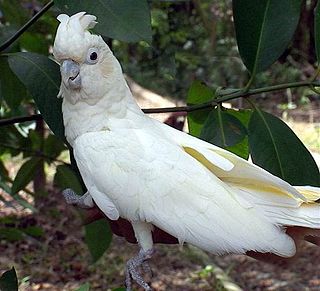 W
WCeratocentron is a critically endangered genus of plants in family Orchidaceae. It contains only one known species, Ceratocentron fesselii, found at high altitudes from Nueva Vizcaya and Nueva Ecija to the Cordillera Mountain ranges on Luzon island in the Philippines. The holotype was discovered in northern Nueva Ecija. The species is rare in the wild, and remained unknown to science until 1989.
 W
WThe red-vented cockatoo, also known as the Philippine cockatoo and locally katala, abukay, agay or kalangay, is a critically endangered species of cockatoo that is endemic to the Philippines. It is roughly the size and shape of the Tanimbar corella, but is easily distinguished by the red feathers around the vent.
 W
WPennant's colobus or Pennant's red colobus is a species of tree-dwelling primate in the family Cercopithecidae. It is endemic to tropical Central Africa. Three subspecies have traditionally been recognised but its distribution is peculiarly disjunct and has been considered a biogeographical puzzle. with one population on the island of Bioko, a second in the Niger River Delta in southern Nigeria, and a third in east-central Republic of Congo. It is found in rainforests and marshy forests. It is threatened by habitat loss and hunting for bushmeat. One subspecies, bouvieri, is rated as critically endangered; although it was last photographically documented in 2015, it may be on the brink of extinction.
 W
WThe Rondo dwarf galago or Rondo bushbaby is a species of primate in the family Galagidae. The dwarf galagos are the smallest members of the genus Galagoides. It weighs less than 100 grams, making it the smallest known galago. It is endemic to Tanzania where its natural habitat is subtropical or tropical dry forests. It lives in an area reported in 2012 to be less than 100 square kilometers and is threatened by habitat loss due to logging. While it was discovered in the 1950s, the Rondo dwarf galago was deemed data deficient until 1996. In 1996, the Rondo bushbaby was fully described as a species. It is now listed as one of "The World's 25 Most Endangered Primates." In 2010, it was also added to the Zoological Society of London's list of genetically distinct and endangered mammals.
 W
WThe giant panda, also known as the panda bear or simply the panda, is a bear native to south central China. It is characterised by large, black patches around its eyes, over the ears, and across its round body. The name "giant panda" is sometimes used to distinguish it from the red panda, a neighboring musteloid. Though it belongs to the order Carnivora, the giant panda is a folivore, with bamboo shoots and leaves making up more than 99% of its diet. Giant pandas in the wild will occasionally eat other grasses, wild tubers, or even meat in the form of birds, rodents, or carrion. In captivity, they may receive honey, eggs, fish, yams, shrub leaves, oranges, or bananas along with specially prepared food.
 W
WThe black crested gibbon is an endangered species of gibbon found in China, Laos, and northern Vietnam, with four subspecies.
 W
WThe lar gibbon, also known as the white-handed gibbon, is an endangered primate in the gibbon family, Hylobatidae. It is one of the better-known gibbons and is often kept in captivity.
 W
WThe Bornean white-bearded gibbon,, also known as the Bornean agile gibbon or southern gibbon, is a species of gibbon endemic to southern Borneo. It is an endangered species, due to the undergoing logging of the tropical forests, between the Kapuas and Barito rivers. Additional issues are of concern to the endangerment of white-bearded gibbons and threatening to other arboreal primates.
 W
WThe goliath frog otherwise known as goliath bullfrog or giant slippery frog is the largest living frog. Specimens can grow up to 32 centimetres (13 in) in length from snout to vent, and weigh up to 3.25 kilograms (7.2 lb). This species has a relatively small habitat range in Cameroon and Equatorial Guinea. Its numbers are dwindling due to habitat destruction and its collection for food and the pet trade.
 W
WThe indri, also called the babakoto, is one of the largest living lemurs, with a head-and-body length of about 64–72 cm (25–28 in) and a weight of between 6 to 9.5 kg. It has a black and white coat and maintains an upright posture when climbing or clinging. It is monogamous and lives in small family groups, moving through the canopy, and is purely herbivorous, feeding mainly on leaves but also seeds, fruits, and flowers. The groups are quite vocal, communicating with other groups by singing, roaring and other vocalisations.
 W
WPinus wangii, commonly known as the Guangdong white pine, is a species of conifer in the family Pinaceae.
 W
WThe tiger is the largest extant cat species and a member of the genus Panthera. It is most recognisable for its dark vertical stripes on orange-brown fur with a lighter underside. It is an apex predator, primarily preying on ungulates such as deer and wild boar. It is territorial and generally a solitary but social predator, requiring large contiguous areas of habitat, which support its requirements for prey and rearing of its offspring. Tiger cubs stay with their mother for about two years, before they become independent and leave their mother's home range to establish their own.